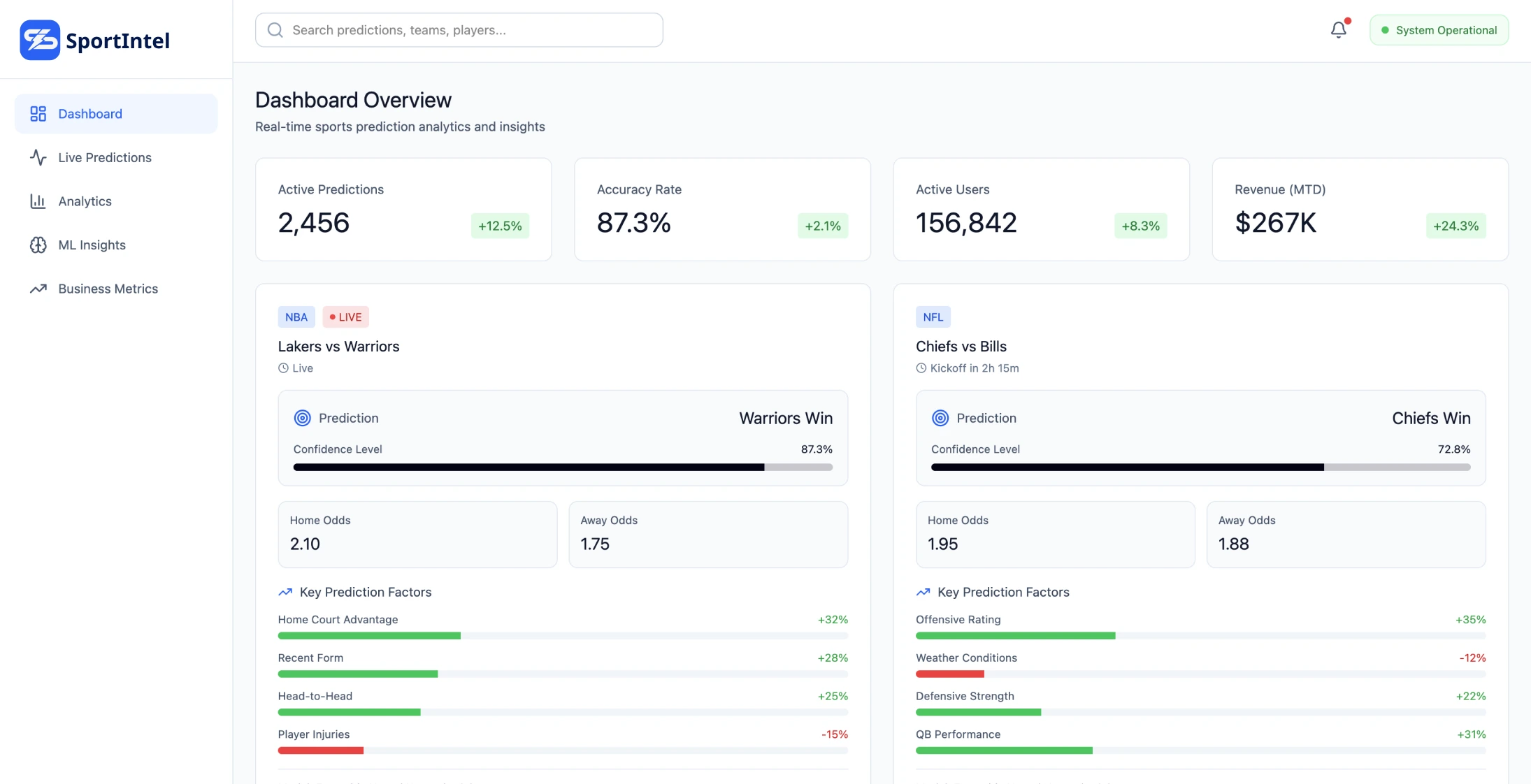
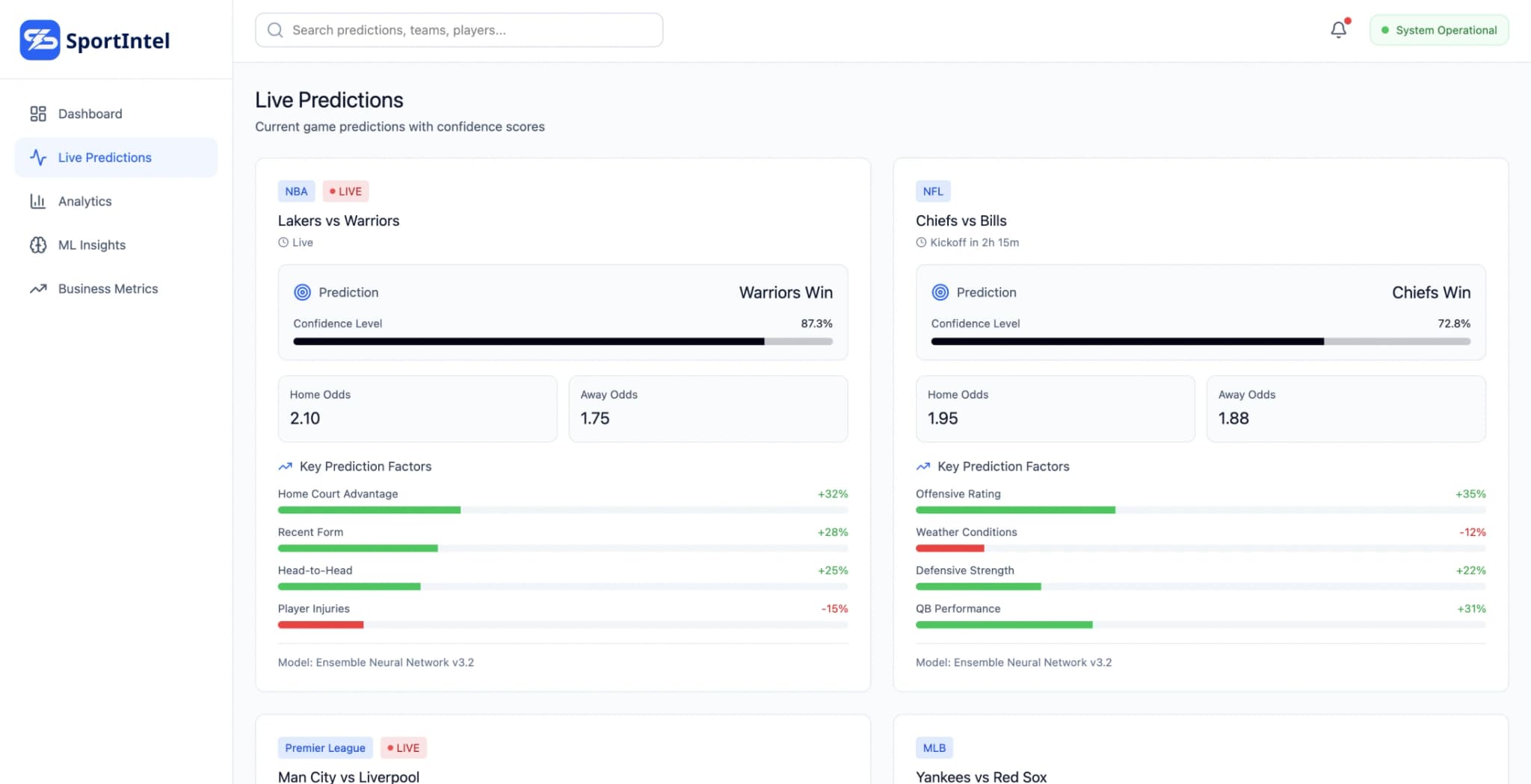
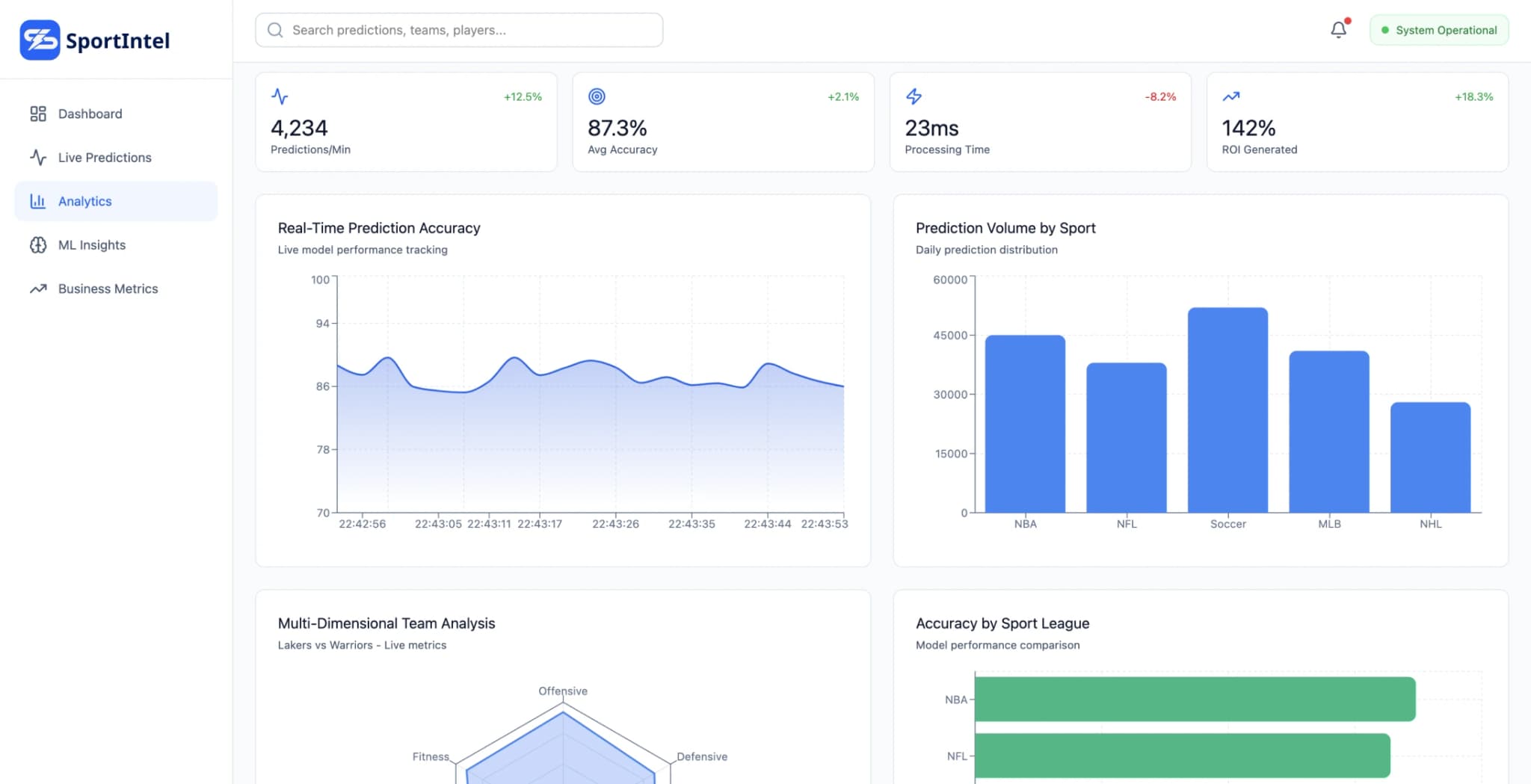
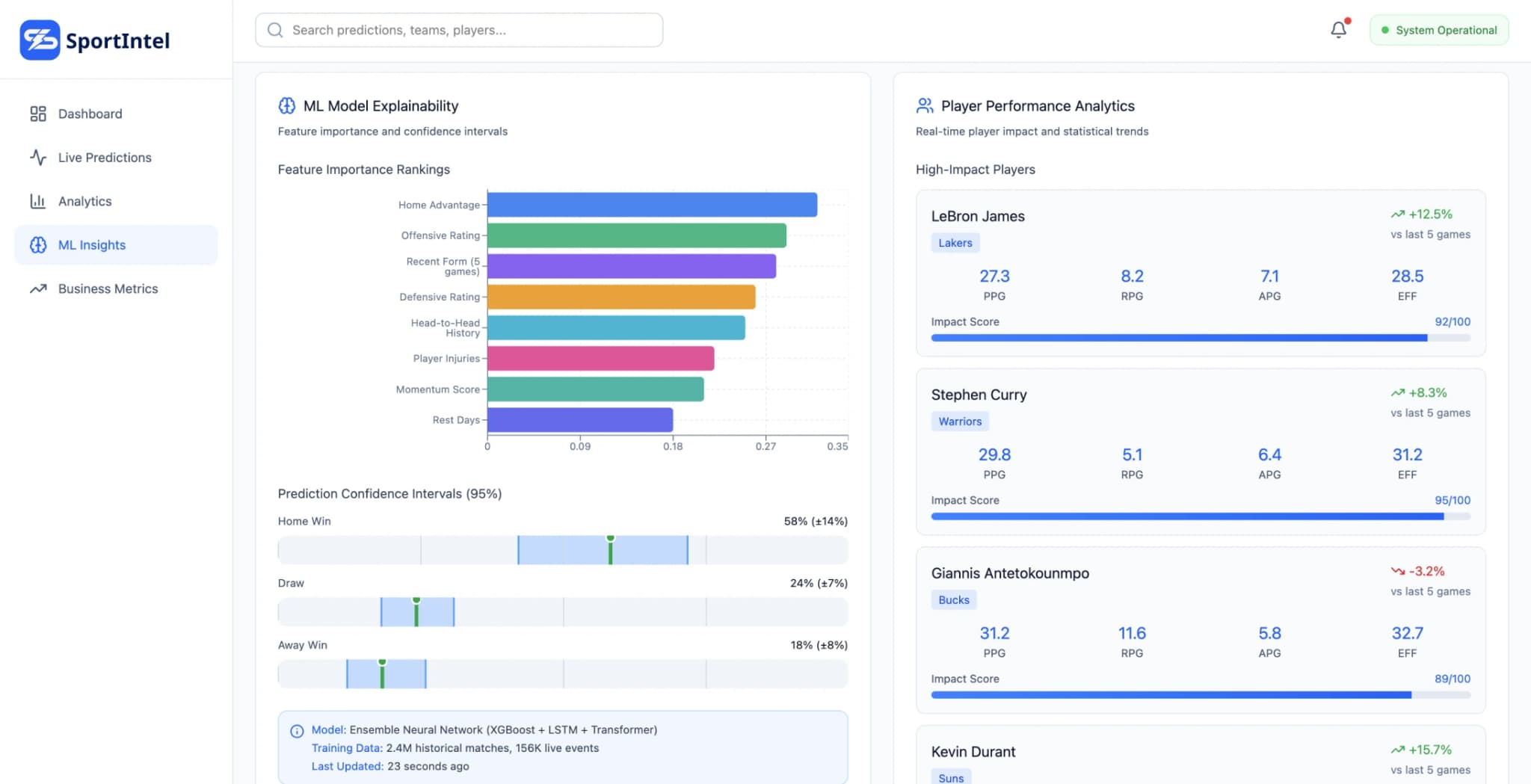
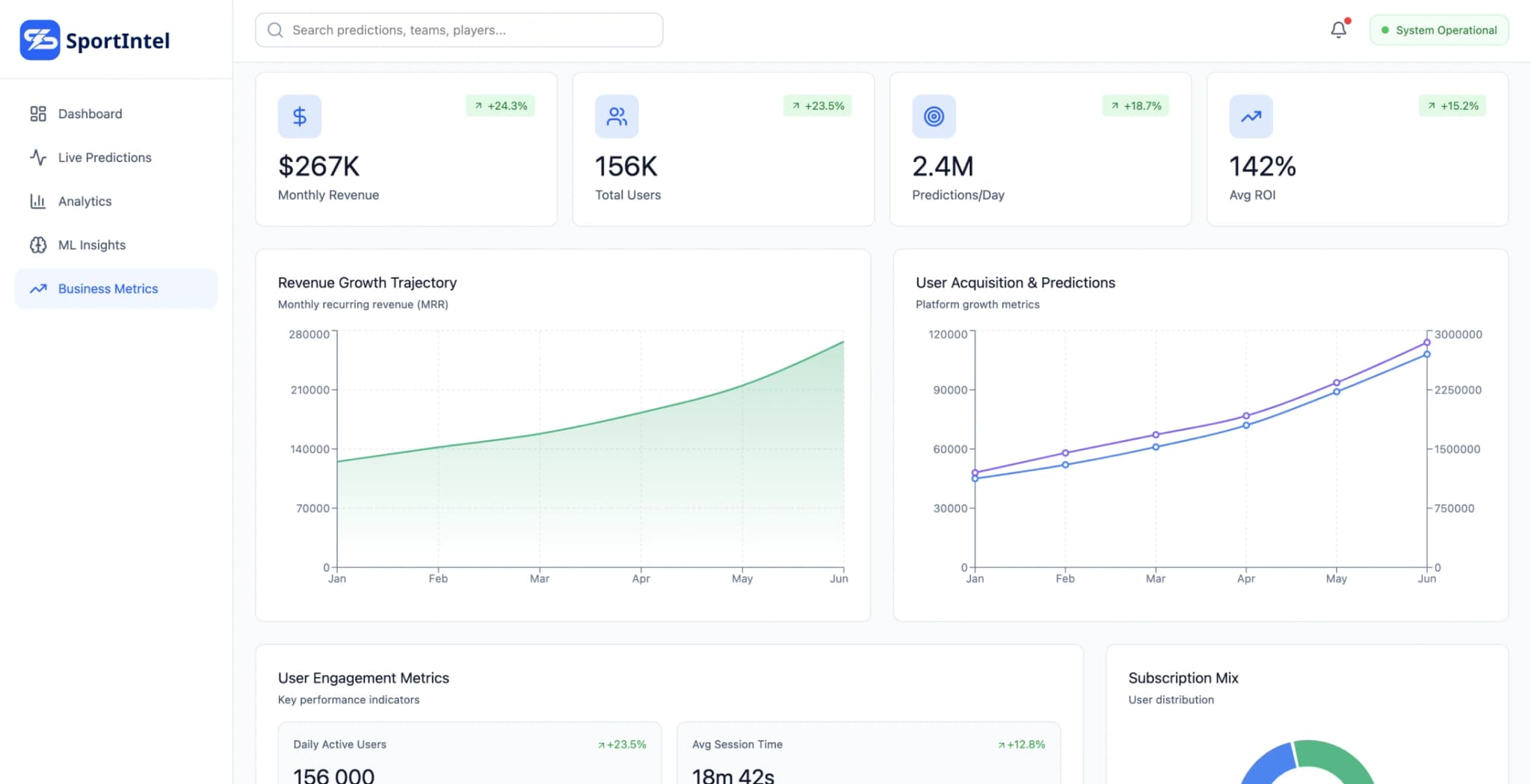
Project Overview
Sports prediction platforms have encountered obstacles in achieving precision and transparency while managing real-time analysis of data sources related to games and player statistics alongside external variables.
The integration of a distributed analytics architecture driven by intelligence that combines machine learning models and real-time data pipelines while continuously adapting and retraining models has led to notable enhancements in the accuracy of predictions.
Performance Results
The system achieved significant improvements across multiple metrics:
- 78% enhancement in forecasting precision
- Reduced inference time from 2.33 seconds to 340 milliseconds
- 165% boost in user interaction during traffic times
- 99.96% consistent uptime
- 2+ million forecasts handled daily across 15 different sports leagues
- Automated model drift recognition and fixes to maintain accuracy over time
The sports betting and fantasy sports industries require responses during peak times and accurate predictions with clear explanations, without any delay for users making important decisions at critical moments in the game.
Challenges with Previous Systems
Data Processing Limitations
Previous prediction systems had several drawbacks that affected performance:
- Batch processing delays led to gaps between real-time events and updated predictions
- Black box algorithms provided no visibility into prediction reasoning
- Lack of transparency made it difficult for users to understand or verify recommendations
Model Performance Issues
- Gradual accuracy decrease over time without retraining
- System failures during peak traffic times like playoff games
- Data quality issues from inconsistent sources disrupted prediction accuracy
Business Impact
Improved Decision Support Quality
The platform delivered substantial improvements in user value:
- Accuracy increased from 52% to 78% across sports disciplines
- Removed 2-second prediction delays that caused user abandonment
- 165% boost in active users
- 89% increase in session duration
Revenue Growth
Transform Your Sports Analytics
Experience 240% growth in premium subscriptions with AI-powered predictions.
- 240% increase in premium subscription sign-ups
- 156% boost in API usage revenue from fantasy sports platforms
- 85% reduction in manual intervention needs
- 42% decrease in infrastructure costs while handling increased traffic
Technical Architecture
Core Platform Design
The platform utilized a microservices framework that integrated:
- Real-time data intake
- Combined machine learning models
- Dynamic model supervision methods
- Streaming analytics for concurrent live sports data
AI and Machine Learning Integration
The system emphasized explainable AI methods to help users understand prediction reasoning:
- Feature importance scores and confidence intervals
- Gradient boosting for team-level predictions
- Neural networks for player performance projections
- Time series models for momentum analysis
Scalability Features
- Horizontal scaling through deployments
- Automated model versioning
- A/B testing frameworks for continuous improvement
- Edge caching and content delivery networks for global users
System Components
Data Ingestion Layer
Data Sources and Processing
| Component | Technology | Processing Time |
|---|---|---|
| Sports Data APIs | Kafka Streaming | Real-time |
| Social Media APIs | Kafka Streaming | Real-time |
| Weather Services | Kafka Streaming | Real-time |
| Betting Exchanges | Kafka Streaming | Real-time |
Feature Engineering Pipeline
- Spark-based distributed computing cluster
- Creates metrics and rolling statistics
- Performs matchup analysis
- 200ms processing windows for feature generation
Model Serving Infrastructure
- Kubernetes deployment for model servers with enterprise blockchain architecture
- Automatic capacity adjustment based on traffic patterns
- API Gateway with load balancing for REST and WebSocket endpoints
- Rate limiting and authentication integration
Real-Time Dashboard
- React-based frontend with WebSocket streams
- Live prediction updates
- Interactive visualization components
- MLflow integration for model management
Implementation Strategy
Phased Rollout Approach
The project progressed in stages:
- 1.Trial models for high-viewership sports
- 2.Gradual expansion to cover full leagues
- 3.Initial focus on basketball and football due to data availability
- 4.Parallel processing validation of new vs. current predictions
Testing and Quality Assurance
The test plan encompassed unit tests for system parts, integration tests for data pipeline reliability, and end-to-end tests to mimic real-world gaming situations.
Comprehensive testing included:
- Unit tests for individual components
- Integration tests for data pipeline reliability
- End-to-end tests mimicking real gaming situations
- Load tests for 10x traffic surge scenarios during major sports events
Risk Mitigation
- Circuit breakers to prevent cascading failures
- Automated backup systems for service continuity through professional blockchain consulting
- Model drift detection and automated retraining
- Data quality monitoring with validation pipelines
Performance Analysis
Sport-Specific Results
- Basketball and football showed highest improvements due to advanced statistical tracking
- Model accuracy varied based on sport complexity and data availability
- User engagement correlated directly with prediction accuracy improvements
Technical Performance Metrics
- Real-time monitoring of data quality maintained model performance
- Ensemble methods outperformed single algorithms for complex sports
- A/B testing frameworks enabled performance evaluation beyond accuracy metrics through comprehensive security audits
Infrastructure Optimization
- Auto-scaling strategies adapted to sports-specific traffic patterns
- Seasonal adjustments accommodated game schedules and playoff periods
- User feedback integration created improvement loops for model enhancement
Technology Stack
Backend Infrastructure
- FastAPI for API layer integration
- WebSocket for real-time communications
- Kubernetes for container orchestration
- Kafka for streaming data processing
Frontend Technologies
- React for user interface development
- D3.js for data visualization
- WebSocket clients for real-time updates
- Responsive design for multi-device support
Conclusion
The implementation of this distributed analytics architecture has transformed sports prediction capabilities, delivering substantial improvements in accuracy, user engagement, and business metrics while maintaining cost efficiency and system reliability.
Success required careful attention to data quality monitoring, model interpretability, and infrastructure scaling to handle the unique demands of real-time sports prediction.
Project Results
- 78% enhancement in forecasting precision
- Reduced inference time from 2.33 seconds to 340 milliseconds
- 165% boost in user interaction during traffic times
- 99.96% consistent uptime achieved
- 2+ million forecasts handled daily across 15 sports leagues
Key Performance Metrics
Accuracy Enhancement
Forecasting precision improvement
System Uptime
Consistent availability
User Interaction
Boost during peak traffic
Daily Forecasts
Predictions across 15 leagues


